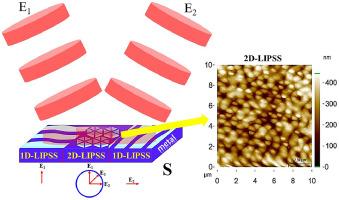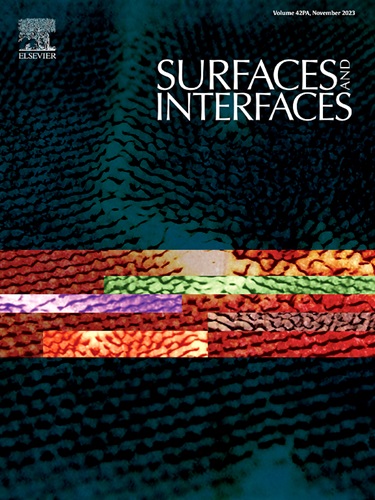双脉冲配置诱导钨表面纳米波纹演变
IF 5.7
2区 材料科学
Q2 CHEMISTRY, PHYSICAL
引用次数: 0
摘要
激光诱导周期性表面结构(LIPSS)的可调形状和均匀性因其在科学研究和技术进步中的广泛应用而备受关注。在这项工作中,我们研究了钨表面上规则的一维(1D)LIPSS 的发展过程,并根据启动纳米波纹形成的两个激光脉冲之间的时间延迟研究了其演变过程。一维 LIPSS 是在大约 84 个激光脉冲的单束激光烧蚀情况下形成的。利用两束交叉偏振激光(波长为 1030 nm,脉冲持续时间为 40 fs)生成了二维(2D)LIPSS,包括三角形、六角形和正方形,脉冲之间没有延迟。然而,在两个交叉偏振激光脉冲之间引入 2 皮秒(ps)的时间延迟后,最初交叉取向的二维-LIPSS 被分割成方形结构,尤其是沿着激光束的空间重叠区域。我们在自组织模型的框架内分析了三角形和六边形二维激光诱导周期性表面结构(2D-LIPSS)的出现,特别是在钨表面低温条件下熔融层凝固的背景下。我们研究了 LIPSS 的形成机理,最初将其归因于自组织/流体动力学机理的结合,随着有效脉冲数的增加,该机理过渡到电磁机理。本文章由计算机程序翻译,如有差异,请以英文原文为准。

Nanoripples evolution on tungsten surface induced by two-pulse configuration
Tuneable shapes and uniformity of the laser-induced periodic surface structures (LIPSS) attract interest because of their diverse applications in both scientific research and technological advancements. In this work, we investigate the progression of regular one-dimensional (1D) LIPSS on a tungsten surface, examining its evolution based on the time delay between two laser pulses that initiate the formation of nanoripples. 1D-LIPSS were formed in the case of single-beam laser ablation with approximately 84 laser pulses. Two-dimensional (2D) LIPSS, including triangle, hexagonal, and square shapes, were generated by employing two cross-polarized laser beams (with wavelengths of 1030 nm and pulse durations of 40 fs) with no delay between the pulses. However, introducing a time delay of 2 picoseconds (ps) between the two cross-polarized laser pulses resulted in the division of the initially cross-oriented 2D-LIPSS into square-shaped structures, particularly along the spatially overlapped region of the laser beams. The emergence of triangle- and hexagonal-shaped two-dimensional laser-induced periodic surface structures (2D-LIPSS) is analyzed within the framework of a self-organization model, particularly in the context of solidifying the molten layer under cold temperature conditions on the tungsten surface. We examine the formation mechanism of LIPSS, attributing it to a combination of the self-organization/hydrodynamic mechanism initially, which transitions to the electromagnetic mechanism as the effective number of pulses increases.
求助全文
通过发布文献求助,成功后即可免费获取论文全文。
去求助
来源期刊

Surfaces and Interfaces
Chemistry-General Chemistry
CiteScore
8.50
自引率
6.50%
发文量
753
审稿时长
35 days
期刊介绍:
The aim of the journal is to provide a respectful outlet for ''sound science'' papers in all research areas on surfaces and interfaces. We define sound science papers as papers that describe new and well-executed research, but that do not necessarily provide brand new insights or are merely a description of research results.
Surfaces and Interfaces publishes research papers in all fields of surface science which may not always find the right home on first submission to our Elsevier sister journals (Applied Surface, Surface and Coatings Technology, Thin Solid Films)
 求助内容:
求助内容: 应助结果提醒方式:
应助结果提醒方式:


